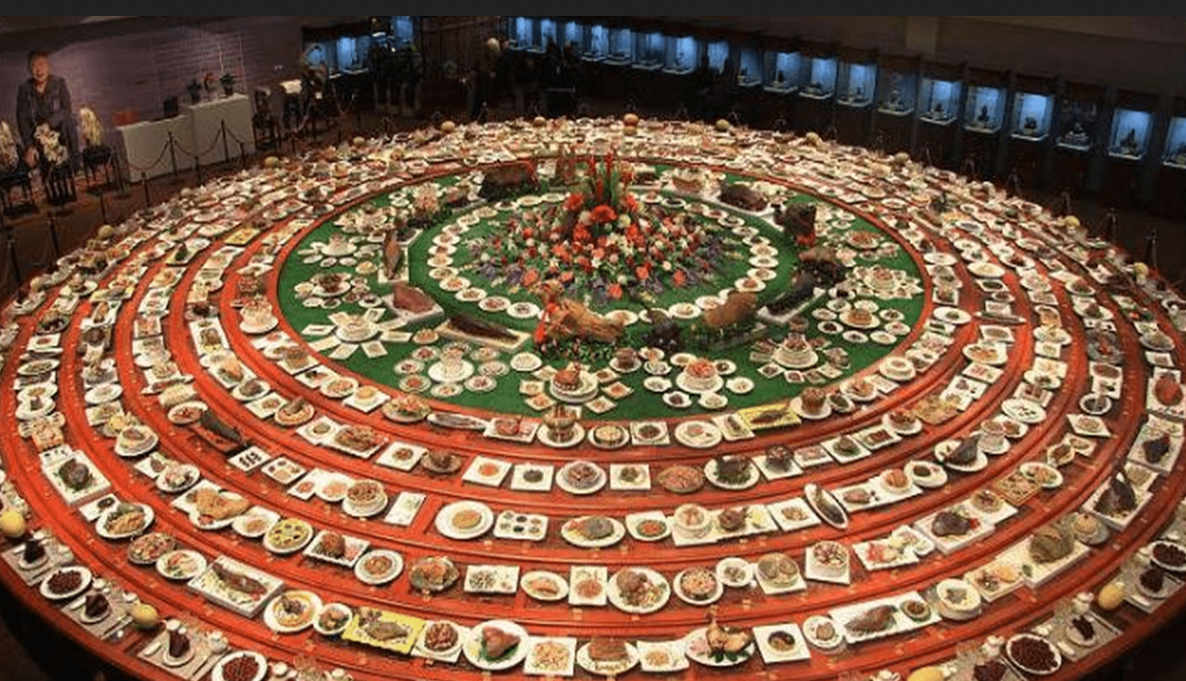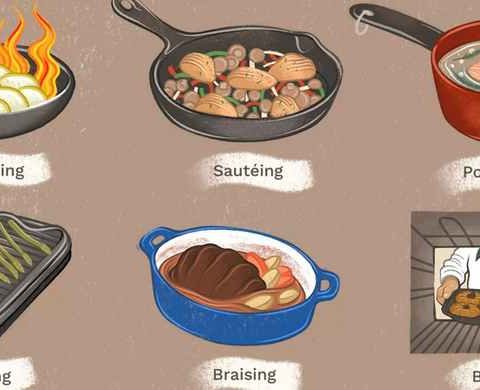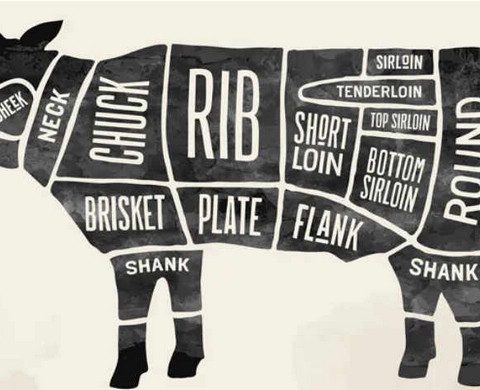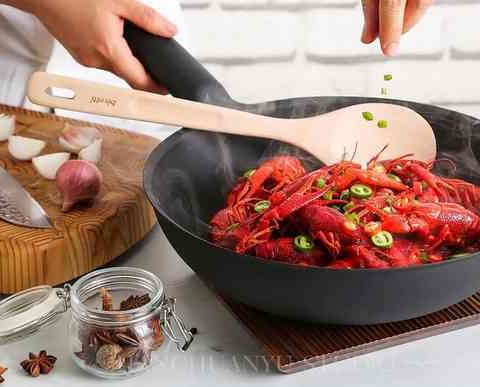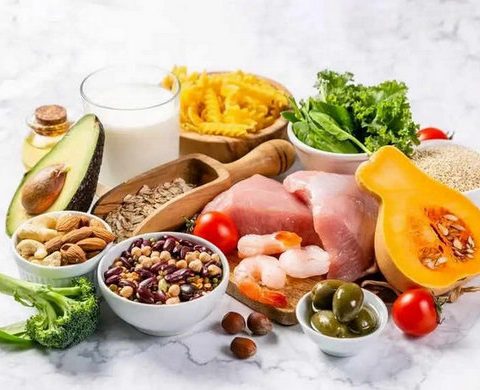Chinese cuisine is famous the world over. Its fame was not achieved in a day. China is an ancient civilization and the cuisine developed with it through its 5,000 years of recorded history. Chinese cooking is a crys-tallization of the imagination and diligence of Chinese cooks these thousands of years.
In the remote, primitive beginnings of mankind’s existence our ancestors led a life eating what has been described as “raw meat with fur and blood.” There was no such thing as cooking. Archaeologists have conjectured that cooking began with forest fires. Lightning storms naturally caused forest fires. Primitive man would flee from the conflagration and return to the forests when the fire was over. The animals which had not escaped were now cooked, as it were and hungry primitive man found the smell of a burned carcass appetizing and the cooked meat better tasting than raw meat. Man came to know that cooking made his food tasty. He preserved kindlings for fire, and discovered methods to make fire by rubbing sticks together, striking flint and stone. Cooked food became a universal phenomenon, the Chinese word”peng” from “peng tiao” meaningthe art of cooking originates from the use of fire in cooking.
People learned to cook food but they did not know how to flavor their food. It is possible that after many years primitive peoples living in coastal areas left their kill on the seashore by chance. The meat may then have been covered with salt crystals from evaporated sea water. Whenthese salt covered meats were cooked, they tasted better. As a consequence primitive man learned to collect salt for flavoring. The word”tiao” of”peng tiao” means flavoring and flavoring originated from the use of salt.
The discovery of cooking and flavoring played a significant role inthe evolution of mankind and the development of human society. The fact that man no longer ate raw meat differentiated humans from other animals. Cooking and flavoring killed germs in food, made it more digestable and nutritious. People gradually cultivated the taking of meals at regular times of the day. Cooked food improved man’s physical and intellectua labilities and this led to the development of his productive forces. Mankind gradually emerged from the age of barbarism and moved towards civilization.
when was chinese food invented
Chinese culinary arts have gone through thousands of years of refinement and development. When man first learned how to cook, the methods were very simple. They simply put food on the fire to bake on hot stones. Pottery was eventually invented, and with it came a variety of cooking utensils: the”ding”, the”li”, the “yan”and the”zeng”. These were combinations of pots and stove. Different methods of cooking developed at the same time. Man began to cook by wrapping his food with mud and straw before roasting; roasting food directly over the fire; first slicing the meat and roasting the sliced meat on a spit; putting the food in a cooking utensil with water to boil; putting food over water to steam it. Oil in cooking came much later. Before the Han Dynasty (206 B.C.) only animal fat was used. According to”Zhou Li”(a book on the governmental system of the Zhou Dynasty) the kings of the Zhou Dynasty ate lamb and piglet cooked in butter in the spring. They ate dried chicken and fish cooked in dog fat in the summer. In the autumn they ate veal and fawn cooked in lard and in the winter, fresh fish and wild geese cooked in sheep fat. In the Han Dynasty (206 B.C.— 220 A.D.) plant seeds were pressed for their oil. The use of these oils for cooking accelerated the development of culinary art.People learned first to fry and then to crackle fry,sauté or stir-fry over a blazing fire.
With progress, the increasing varieties and abundance of foods, experimentation and study, the Chinese culinary arts have been perfected through the ages. Ancient history books, the “Zhou Li”and the “Li Ji” mention eight precious foods prepared for kings. They may have been ways of preparation or they may simply have been eight famous dishes. One ofthem was roast ewe. Its preparation is more complicated than today’s “roast suckling pig”. The preparation involved roasting, frying and stewing. Ingredients included rice flour, thick soybean paste, vinegar and spices. The recipes show the sophistication of the culinary arts at that time.
Chinese Cuisine in Warring States Period
During the Warring States Period, Qu Yuan, the great poet of the State of Chu, (340-278 B.C.) wrote an essay entitled:”Call Back the Souls”. It was a tribute to the dead generals and soldiers of Chu. The essay contained a long menu including such dishes as Beef, Roast Soft-shelled Turtle, Roast Lamb, Wild Goose, Steamed Duck, Spiced Chicken, BraisedTurtle, Fish Soup, Pork Meatballs and Quail Soup. Flavorings included soy sauce, vinegar, salt, plum, molasses and honey to make the dishes taste salty pungent or sweet. Cooking techniques were complicated and numerous. The only methods absent were the frying techniques. By the late Warring States Period, an essay on culinary theory appeared. This was the “Chapter on Natural Tastes” in the “Annals of Lu”. The essay pointed out that the control of the flame and mastery of seasonings were crucial to good cooking. The right flame, the proper cooking time and the appropriate use of seasonings would eliminate the unwanted and bring out the best flavors in food.
Chinese Cuisine in Han Dynasty
During the Han Dynasty, Zhang Jian (?—114 B.C.) brought back alfalfa, grapes and other new foods from his travels to the west. Walnuts, broad beans, carrots, onions, pepper and cucumbers were also introduced to China. Meanwhile beancurd and many bean products were invented in China. With the increase in the variety of foods, cooking techniques developed.
Chinese Cuisine in Wei, Jin, the Northern and Southern Dynasties
During the Wei, the Jin, the Northern and Southern Dynasties (220— 587) there was, in China, a massive migration and mixing of peoples of various ethnic origins. The resulting meeting of cultures and customs naturally included an exchange of foods and cooking styles. Roasting and quick boiled meat slices came from the peoples of Xinjiang and the Central Asia. Hot pepper oil and a fish flavor sauce came from the peoples of southwest Hunan and Sichuan. From Fujian and Guangdong in the south came roast pork and raw fish and from the southeast coast of China came distinctive seafood cooking. The various styles of cooking complemented and enriched each other. The book “Qi Min Yao Shu” written by Jia Sixie, a well-known scholar of Northern Wei Dynasty describes a number of cooking techniques and includes many recipes. It is an important work on the agriculture and culinary arts of China.
Chinese Cuisine in Tang, Song Dynasty
By the Tang Dynasty (618—907) China was the most powerful empire in the east. Domestic stability and a flourishing culture attracted many people from other countries and they came to learn. Culinary arts were flourishing as well. Not only were color, smell and taste important,shape and design of the dish had become essential to gourmet cooking. Evidence of this can be found in “Recipes” by Wei Quyuan of the TangDynasty; in”Yu Gong Pi” written by palace chefs of the Song Dynasty; and in “Zhong Kuei Lu” by Wu Shi of Pujiang also of the Song Dynasty. The Tang Dynasty “Recipes” mentions a dish called, “Fragrance Through the Doors”. The style of cooking is similar to the”Quan Bao” frying method found in Beijing cooking. It is evidence of the sophistication that frying techniques had reached by that time.
Chinese Cuisine in Ming, Qing Dynasty
During the Ming and Qing Dynasties (14th—20th century) the development of sea transportation brought such delicacies as shark’s fin, sea cucumber and bird’s nest to the banquet table. These were usually preserved in dried form and had to be soaked and reconstituted in water or other liquids before cooking. The skill was a special one and the chefs of the Ming and Qing Dynasties had mastered it. Shark’s fin, sea cucumber and bird’s nest are themselves very bland. Their delicacy is in their texture and the balance of seasonings to complement the texture. “Menus of the Sui Garden” written by QingDynasty scholar Yuan Mei (1716 —1798) is a masterpiece on Chinese cuisine. The author describes not only the preparation of the many delicacies and sumptuous foods he had sampled, he expounds on the theories of cooking and his own analysis of them. In the Qing Dynasty, a luxurious Manchu-Han banquet was made up of six major courses, six minor courses, four accompanying courses, two or three desserts and 24 trays (4 ofdried fruits, 4 of fresh fruits, 4 of preserved fruits, 8 cold foods and 4 hot foods). In addition, the guests were served appetizers and two courses of tea before the meal. The banquet was extravagant and wasteful, but it brought together the best of Han-Manchu cooking and was a magnificent display of the exquisiteness of Chinese cuisine.
